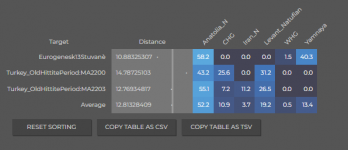Stuvanè
Regular Member
- Messages
- 607
- Reaction score
- 609
- Points
- 93
- Location
- Milan
- Ethnic group
- Italian
- Y-DNA haplogroup
- J2
- mtDNA haplogroup
- H1e
Thank you for replying Stuvanè. I’m not aware of any Hittite samples. Is there a paper that published something on them?
Regarding the main topic, I appreciate your comments. I think I made a mistake in my original post with the Iranian hypothesis about comparing between the hypothetical Levantines that immigrated to Iran and the Mycenaean Greeks. My original point was that it is possible for a migrating population (Indo-Europeans, Levant_N) to migrate to another population and admix with them (Native population of Greece, Iran_N) replacing their language but not their Y-DNA. (In the case of native population of Greece, to Mycenaean Greek; in the case of Iran_ChL, to pre-proto-Semitic. However, if J arrived in Greece after the Indo-Europeans, then that invalidates my example. That would make it like the Basque example actually, because the Y-DNA was replaced but not the language, Mycenaean Greek.
Do you know of any examples where an immigrant population replaced the language but not the Y-DNA?
For what very little I know, I believe that the only 2 samples that can be traced back to the Hittites for now (or a Hittite context between the 19th and 16th centuries BC) are MA2200 and and MA2203 and the reference study should be the following (I don't have direct access to the paper so what I'm telling you take it with a grain of salt)
https://www.science.org/doi/10.1126/science.aar7711
I tried to spin their k13 coordinates with some ancestral components (the model is very rudimentary, there are certainly better ones) and I seem to see 2 individuals with a strong Anatolian base, very mixed with both Levant and CHG and / O Iran_N. (The third is me ...)

As for the linguistic substitution not accompanied by actual genetic substitutions - perhaps these examples are a little stretched and not fitting at best - but I would say that the Sardinians and the French are cases in which in fact the local pre-Roman populations have persisted and genetically modified in negligible part by the invaders, while the language has been irreversibly changed




